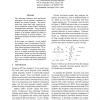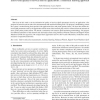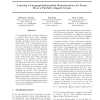119 search results - page 19 / 24 » Measuring Word Alignment Quality for Statistical Machine Tra... |
EMNLP
2009
13 years 5 months ago
2009
Tree Adjoining Grammars have well-known advantages, but are typically considered too difficult for practical systems. We demonstrate that, when done right, adjoining improves tran...
EMNLP
2008
13 years 9 months ago
2008
Parallel web pages are important source of training data for statistical machine translation. In this paper, we present a new approach to sentence alignment on parallel web pages....
CN
2010
13 years 7 months ago
2010
The focus of this work is on the estimation of quality of service (QoS) parameters seen by an application. Our proposal is based on end-to-end active measurements and statistical ...
TSD
2007
Springer
14 years 1 months ago
2007
Springer
The world wide web is a natural setting for cross-lingual information retrieval. The European Union is a typical example of a multilingual scenario, where multiple users have to de...
ICML
1998
IEEE
14 years 8 months ago
1998
IEEE
Cross-language latent semantic indexing is a method that learns useful languageindependent vector representations of terms through a statistical analysis of a documentaligned text...



